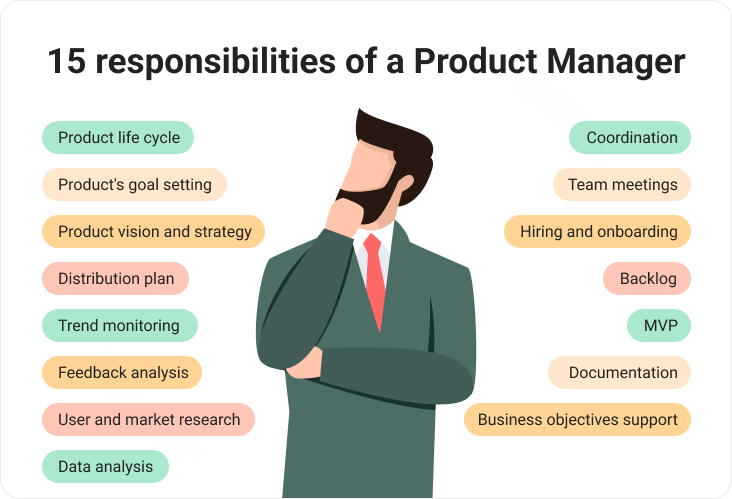In today’s rapidly evolving tech landscape, the role of a Product Manager is more vital—and challenging—than ever before. Gone are the days when traditional methods could cut it; in 2024, PMs face unique hurdles that demand innovative solutions.
Whether it’s aligning teams, understanding customer needs, or managing tight deadlines, the struggles are real.
But fear not! Our latest blog post unveils the top 9 internal best practices every successful Product Manager should adopt. Here, we’ve distilled the essence of what works, providing you with the toolkit needed to excel in today’s competitive environment. Read on to transform challenges into opportunities.
Understanding the Role of an Internal Product Manager
When we dig into the nitty-gritty of what makes an internal Product Manager (PM) tick, it’s like discovering the engine room of a great ship. These folks are steering the product from the inside, aligning the team’s goals, and ensuring every feature or product update hits the mark for their own company.
Unlike their external counterparts who focus on the customer experience outside the company, internal PMs serve the needs within the business, making their role uniquely challenging and incredibly rewarding.
Distinctions between Internal and External Product Managers
Internal PMs are laser-focused on improving the product for their company’s use, aiming to boost efficiency, productivity, or profitability. They’re like the conductors of an intricate orchestra within the company, ensuring each department is in harmony.
External PMs, on the other hand, are looking outward, constantly scanning the horizon for ways to enhance the user experience for customers outside the company. Their role demands a deep understanding of market trends and customer needs.
Core Responsibilities of an Internal PM
- Product Strategy Formation: Crafting a roadmap that aligns with the company’s goals, ensuring every department understands how the product serves the broader mission.
- Cross-functional Leadership: Acting as a bridge among various departments (like engineering, marketing, and sales), making sure everyone is on the same page.
- Feedback Loop Management: Establishing channels for constant feedback from the use of the product within the company, ensuring it meets internal needs and expectations.
The Significance in 2024
Fast forward to 2024, and the playing field has transformed dramatically. The blend of technological advancements and market shifts is not just redefining the role of the PM; it’s revolutionizing it. It’s not just about keeping up anymore; it’s about staying ahead and predicting internal needs before they become apparent. In this constantly evolving environment, the internal PM’s ability to adapt and innovate becomes crucial.
- Navigating through AI and machine learning to automate and enhance internal processes.
- Utilizing big data to better understand internal usage patterns and predict future needs.
- Spearheaded digital transformation initiatives to keep the company agile and competitive.
In 2024, it’s clear that the role of the internal Product Manager is more critical than ever. With technology reshaping the landscape at breakneck speed, these unsung heroes within our organizations are the ones keeping the ship steady and charting the course toward not just survival but thriving in the new digital age.
Best Practices for Internal Product Managers in 2024
Embrace Data-Driven Decision Making
In the fast-paced world of 2024, Product Managers (PMs) can’t afford to make decisions based on gut feelings alone. The best practice? Lean heavily into data-driven decision-making. This means getting cozy with product analytics tools and not just collecting data but actually using it to make your product better. For instance:
Harnessing Analytics and Metrics: Product Managers should get hands-on with tools like Amplitude or Mixpanel. These platforms can show you how users interact with your product, what features they love, and where they get stuck. It’s like having a high-tech crystal ball.
- Key metrics every PM should monitor:
- User Engagement: How often and in what ways are users engaging with the product?
- Retention Rate: Are users coming back after their first experience?
- Conversion Rate: How many of the users complete a desired action (like signing up for a trial or making a purchase)?
- Making Informed Decisions: Armed with this data, PMs can pinpoint exactly where to focus their efforts for the biggest impact. For instance, if the data shows users dropping off at a specific feature, that’s your cue to investigate and improve.
Case Studies on Data-Driven Success Stories
To see these principles in action, consider the success story of Spotify. By analyzing vast amounts of data on listening habits, they’ve fine-tuned their recommendation algorithms to keep users listening longer. Or take Netflix, which uses viewing data to recommend movies and shows and decide which new content to produce.
These examples underscore the power of data-driven decision-making. By following these best practices, Internal Product Managers in 2024 can ensure their products not only meet their company’s current needs but also anticipate future trends and challenges.
Foster Cross-Functional Collaboration
Breaking Silos
To effectively break down silos within an organization, it’s vital to:
- Encourage Open Communication: Create an environment where team members feel comfortable sharing ideas and feedback. Tools like Slack facilitate quick and informal conversations, which can lead to innovative solutions.
- Set Unified Objectives: Ensure all teams understand the company’s goals and how their work contributes to these targets. This alignment can be fostered through strategic planning tools like Trello or Asana, which help teams visualize project progress and priorities.
Tools and Techniques
- Collaboration Platforms: Utilize tools such as Microsoft Teams to bring disparate teams together in a virtual space, enhancing collaboration and accessibility to shared resources.
- Shared Knowledge Repositories: Implementing systems like Confluence to maintain strategically throughout the content can enhance search engine visibility and engage readers seeking to stay ahead in the field of product management. A central source of truth where all departments can access and contribute knowledge.
Master Agile and Lean Methodologies
Agile vs. Lean: A Comparative Analysis
- Agile Methodology focuses on iterative development, where requirements and solutions evolve through collaboration between self-organizing cross-functional teams. It’s highly adaptable and customer-centric.
- Lean Methodology emphasizes efficiency and waste reduction, aiming to deliver more value with fewer resources. It’s best for optimizing processes and streamlining production.
Implementing Agile and Lean Practices
Quick tips for integration:
- Start Small: Implement the methodologies in small teams or projects first, learning as you go.
- Use Agile Boards: Tools like Jira make it easier to visualize work in progress and adhere to agile principles.
- Lean Kaizen Meetings: Regular meetings focusing on continuous improvement can drive the lean methodology. These ensure the team regularly evaluates and refines their process.
Prioritize User Experience (UX) Design
The Role of UX in Product Success
Good UX design is not just about making things look pretty; it’s about creating products that are intuitive and delightful to use. This means understanding the user’s needs and designing solutions that meet or exceed those needs.
Collaborating with UX Teams
- Regular Check-Ins: Schedule frequent meetings between the product and UX teams to ensure alignment on vision and user needs.
- Prototyping Tools: Leverage tools like Adobe XD or Sketch to quickly create and iterate on designs.
- Implement Continuous Feedback Loops
- Direct User Feedback: Utilize platforms like UserVoice to collect direct feedback from users.
- Stakeholder Reviews: Regular review sessions with stakeholders ensure that feedback is gathered from all directions and incorporated into the development process.
Real-life example:
By implementing a robust feedback system, Dropbox significantly improved its file-sharing feature, making it easier for users to understand and use, which led to increased customer satisfaction and product stickiness.
Stay Ahead with Competitor Analysis
Conducting Thorough Market Research
- Competitor Analysis Tools: Employ tools like SEMrush to understand how competitors rank in search and social media insights.
- Consumer Trend Platforms: Use Google Trends to keep an eye on what’s gaining popularity in your industry or among your target audience.
Learning from the Competition
Understanding what your competitors are doing well (or poorly) can help you make informed decisions about your product development and marketing strategies.
Invest in Personal and Team Development
Keeping Skills Sharp
- Online Learning Platforms: Encourage your team to take courses on sites like Coursera or Udemy to keep up with the latest trends and technologies.
Fostering a Culture of Innovation
- Hackathons and Innovation Challenges: Organize internal events to stimulate creativity and teamwork, potentially unearthing groundbreaking ideas.
Focus on Strategic Product Roadmapping
Crafting a Visionary Roadmap
A successful product roadmap aligns with the company’s strategic goals while being flexible enough to adapt to feedback and market shifts. Tools like ProductPlan can help visualize and share your roadmap.
Adjusting to Market Changes
Staying nimble and being willing to pivot based on new information or feedback is crucial. Regularly revisiting and, if necessary, revising your roadmap ensures your product remains relevant and competitive.
Advocate for Customer-Centricity
Building Products with the Customer in Mind
Using personas and user stories can help keep the user’s needs and experiences at the forefront of product development.
Measuring Customer Satisfaction
Survey Tools: Instruments like SurveyMonkey or Google Forms are invaluable for gauging customer satisfaction and gathering feedback for continuous improvement.
Overcoming Challenges as an Internal Product Manager
Being an internal product manager comes with a unique set of challenges. From aligning divergent team goals to managing stakeholder expectations, the role requires a blend of diplomacy and determination. Below are some common hurdles you might face, along with strategies to overcome them:
- Aligning Team Goals: Sometimes, various departments have conflicting priorities. It’s crucial to bring everyone to the table and focus on the common objective: the product’s success.
- Facilitate Cross-Functional Meetings: Regular brainstorming sessions can foster understanding and collaboration among teams.
- Develop a Unified Vision Document: A single, shared document that outlines the product’s goals, timelines, and key performance indicators (KPIs) can keep everyone aligned.
- Managing Stakeholder Expectations: Stakeholders often have high expectations, sometimes unrealistic, regarding what and how quickly your team can deliver.
- Set Clear Communication Channels: Use tools like Slack for open and ongoing communication.
- Regular Progress Updates: Whether through email newsletters or project management dashboards, keeping stakeholders informed helps temper expectations.
- Adapting to Market Changes: The market can shift unexpectedly, making it necessary to pivot quickly to remain competitive.
- Stay Informed with Market Analysis Tools: Regularly use platforms like SEMrush to monitor trends and competitor strategies.
- Implement a Flexible Roadmap: Tools like ProductPlan allow for easy adjustments and help communicate changes to the team and stakeholders.
- Prioritizing User Feedback: Sifting through user feedback and determining what to act on can be overwhelming.
- Leverage Feedback Platforms: Use UserVoice to collect and prioritize user feedback efficiently.
- Develop a Feedback Integration Plan: Schedule regular review sessions to discuss feedback and decide on actionable items.
These strategies aim to mitigate challenges by promoting clear communication, aligning team and stakeholder expectations, staying adaptable, and being user-focused. Balancing these elements can help internal product managers successfully guide their products to market.
Conclusion
The role of an internal product manager is both challenging and rewarding. The strategies outlined above, from fostering a culture of feedback and innovation to conducting competitor analysis and keeping skills sharp, are pivotal for navigating the complexities of product development.
By focusing on strategic roadmapping and advocating for customer-centricity, product managers can align their team’s efforts with the company’s strategic goals, ensuring the product not only meets but exceeds market expectations.
Additionally, overcoming common challenges such as aligning team goals, managing stakeholder expectations, adapting to market changes, and prioritizing user feedback with thoughtful strategies further enhances a product manager’s capability to lead their product to success. Implementing these strategies requires a commitment to continuous learning and adaptability.
For those looking to deepen their understanding and skills in product management, Learn More about specialized courses and resources that can propel you and your product forward in this dynamic field.
FAQs
What are the top trends affecting internal product management in 2024?
Trends shaping the landscape include the increasing importance of AI and machine learning in product development, the rise of remote work influencing team collaboration, and the focus on sustainability and ethical considerations in product decisions.
How can internal product managers effectively use AI in their strategies?
AI can be leveraged for predictive analytics to guide product development, enhance customer experience through personalized interactions, and automate routine tasks to free up time for strategic planning.
What strategies can be employed to maintain team collaboration in a remote work environment?
Using collaborative tools like Slack and Zoom for communication, conducting regular virtual team-building activities, and implementing digital project management solutions can help maintain cohesion and foster a strong team dynamic.
How can internal product managers stay ahead of rapid market changes?
Staying informed through continuous market analysis, being adaptable with a flexible product roadmap, and cultivating a deep understanding of customer needs and feedback can empower managers to quickly pivot strategies as needed.
What are some effective ways to gather and prioritize user feedback?
Utilizing platforms like UserVoice for feedback collection, implementing a structured framework for feedback evaluation, and conducting regular user research sessions can aid in systematically integrating user insights into product development.




